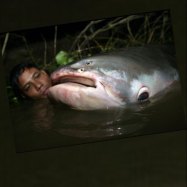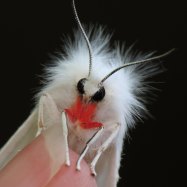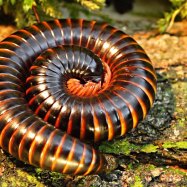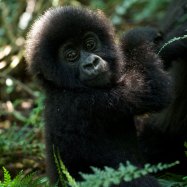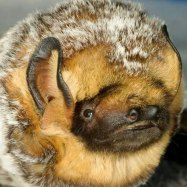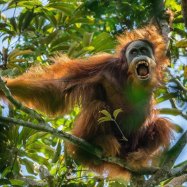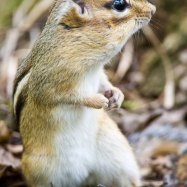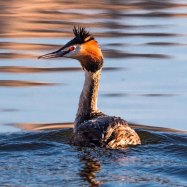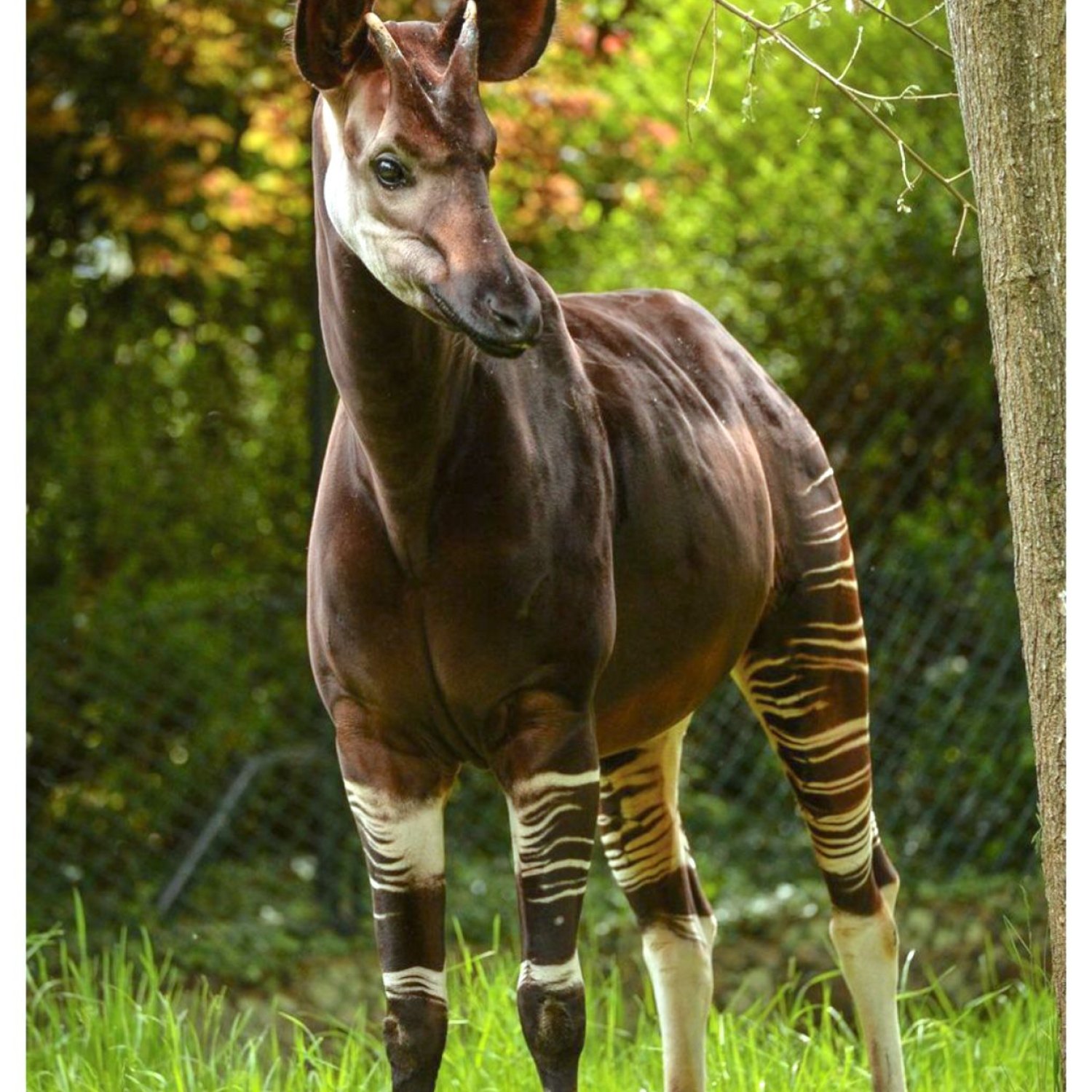
Okapi
6-8.2 feet (1.8-2.5 meters)
The Okapi is a fascinating animal found in Central Africa, with a large, stocky body, long legs, and a short neck. Belonging to the giraffe family, it can reach a length of 6-8.2 feet (1.8-2.5 meters). Despite its size, the Okapi is a skilled runner and can navigate through dense forests easily. Sadly, due to habitat destruction and poaching, this unique animal is listed as endangered. #Okapi #CentralAfrica #EndangeredSpecies
Animal Details Summary:
Common Name: Okapi
Kingdom: Animalia
Habitat: Tropical rainforests
The Elusive Okapi: A Mysterious and Majestic Creature of the Rainforest
Deep within the lush, dense rainforests of the Democratic Republic of Congo, roams a creature that has long evaded the human eye. With its striking appearance and elusive nature, the Okapi is a fascinating animal that has captured the attention of scientists and nature lovers alike.Scientifically known as Okapia johnstoni, the Okapi belongs to the Kingdom Animalia, the Phylum Chordata, and the Class Mammalia. It belongs to the Order Artiodactyla, which includes animals with hooved feet like goats, deer, and giraffes Okapi. The Okapi is also part of the family Giraffidae, making it a distant relative of the giraffe.
The habitat of the Okapi is restricted to the tropical rainforests of the Democratic Republic of Congo in Central Africa. This region is known for its dense vegetation, making it the perfect habitat for the Okapi to thrive. They are herbivores, meaning they feed on plants and vegetation found in the rainforest. This includes leaves, fruits, and buds from a variety of tree species.
The geographical distribution of the Okapi is limited to the Democratic Republic of Congo. They are also known as the "forest giraffe" due to their similarities with giraffes, such as their long legs and unique coat patterns. However, unlike giraffes, Okapis have a much shorter neck, making them well-suited for navigating through the dense forest vegetation.
The Okapi is a truly unique creature, and its appearance is nothing short of mesmerizing Oregon Spotted Frog. With a dark brown to black body and striking white stripes on its legs and rear end, it is a sight to behold. These distinctive stripes are thought to act as camouflage, helping the Okapi blend in with its surroundings and avoid predators.
Speaking of predators, Okapis have very few natural enemies due to their elusive nature. Leopards and humans are the only known predators of this creature. However, with the protection of the Democratic Republic of Congo government and conservation efforts, the population of Okapis is on the rise.
One of the most fascinating aspects of the Okapi is its body shape. Despite its similarities with giraffes, the Okapi has a much stockier and larger body. It stands at an impressive 6-8.2 feet (1.8-2.5 meters) tall and can weigh up to 770 pounds (350 kilograms). Their powerful legs and sharp hooves help them navigate through the rough terrain of the rainforest with ease.
The Okapi also has a unique body shape designed for survival in the rainforest. Their long legs enable them to move quickly and gracefully through the dense vegetation, while their large, stocky body provides them with balance and stability. Their short neck also comes in handy when browsing for food in low-hanging branches.
One of the most intriguing facts about the Okapi is that it was a relatively unknown species until the 20th century. This creature was discovered by European explorers in 1901, making it one of the most recently discovered large mammals. It was first introduced to the Western world in 1907 and has since captured the hearts of many researchers and nature enthusiasts.
The Okapi is also a national symbol of the Democratic Republic of Congo, and it holds a significant cultural and spiritual significance for the local Mbuti and Efe pygmy tribes. According to their beliefs, the Okapi is a messenger from the spirit world, and killing it is considered a bad omen.
Apart from its elusive nature, the Okapi is also known for its unique vocalizations. They produce a variety of sounds, including grunts, whistles, and even bleats like a goat. These vocalizations are used for communication with other Okapis, and they can also make a loud "chuffing" sound when excited or alarmed.
Conservation efforts are essential for the protection of the Okapi, as its population faces threats from poaching and habitat loss due to deforestation. The Okapi Wildlife Reserve, established in 1992, is the world's only reserve specifically designated for conserving this species. The reserve covers an area of 13,700 square kilometers and is home to over 5,000 Okapis.
In addition to protection measures, research and monitoring programs have also been put in place to gather more information about this elusive creature. By understanding their behavior, habitat requirements, and threats, conservation efforts can be more effective in preserving the Okapi for future generations.
In conclusion, the Okapi is a truly fascinating and mysterious animal that has captured the hearts of many. With its unique appearance, elusive nature, and cultural significance, it is no wonder that this creature has become a symbol of conservation and protection. As we continue to learn more about the Okapi, we can work towards ensuring its survival and preserving the beauty and diversity of our planet's rainforests.

Okapi
Animal Details Okapi - Scientific Name: Okapia johnstoni
- Category: Animals O
- Scientific Name: Okapia johnstoni
- Common Name: Okapi
- Kingdom: Animalia
- Phylum: Chordata
- Class: Mammalia
- Order: Artiodactyla
- Family: Giraffidae
- Habitat: Tropical rainforests
- Feeding Method: Herbivore
- Geographical Distribution: Democratic Republic of Congo
- Country of Origin: Democratic Republic of Congo
- Location: Central Africa
- Animal Coloration: Dark brown to black body with white stripes on legs and rear end
- Body Shape: Large, stocky body with long legs and a short neck
- Length: 6-8.2 feet (1.8-2.5 meters)
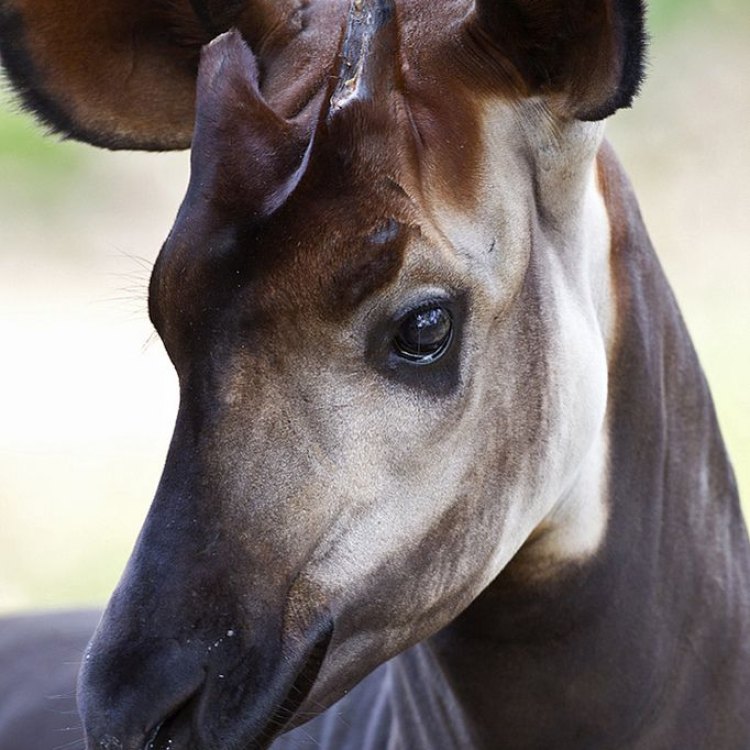
Okapi
- Adult Size: Height at shoulder: around 5 feet (1.5 meters)
- Average Lifespan: Around 20-30 years
- Reproduction: Sexual
- Reproductive Behavior: Polygamous
- Sound or Call: Vocalizations include bleats and bellows
- Migration Pattern: Non-migratory
- Social Groups: Solitary or in small groups
- Behavior: Shy and elusive, mainly active during the day
- Threats: Hunting and habitat loss
- Conservation Status: Endangered
- Impact on Ecosystem: Important seed dispersers
- Human Use: Hunted for meat and their skin
- Distinctive Features: Striped back legs and rear end
- Interesting Facts: Okapis are the only living relatives of giraffes
- Predator: Leopards and humans
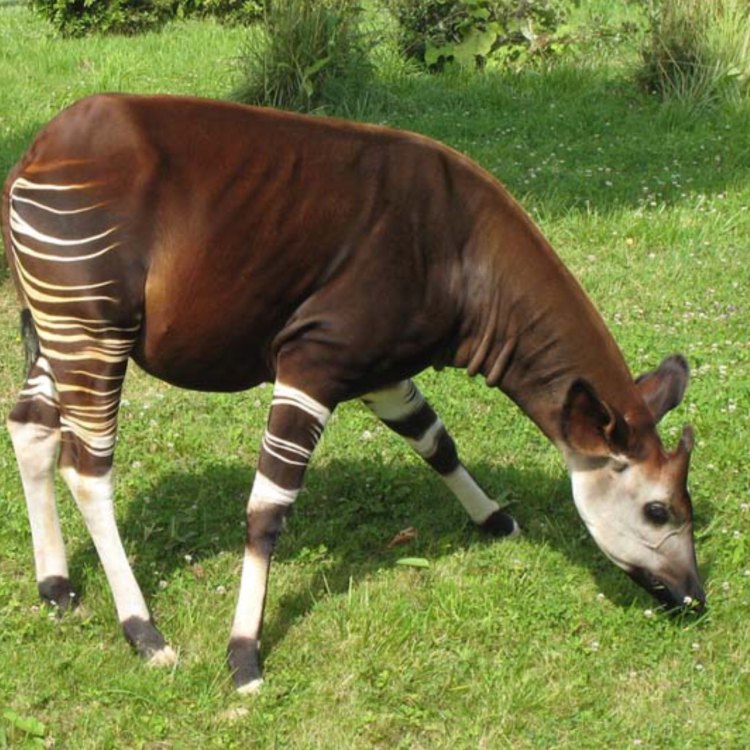
Okapia johnstoni
The Elusive and Endangered Okapi: A Unique Member of the Animal Kingdom
Deep in the tropical forests of the Democratic Republic of Congo, there roams a creature that seems to be a mix of a zebra, a giraffe, and a horse. This elusive and endangered animal is none other than the okapi. With its distinctive striped back legs and rear end, the okapi is often referred to as the "forest giraffe."But despite its unique appearance, the okapi remains a mystery to many PeaceOfAnimals.Com. In this article, we will delve into the world of the okapi, exploring its size, lifespan, behavior, threats, and interesting facts. Join us on a journey to discover the fascinating and often overlooked creature that is the okapi.
The Basics of the Okapi's Physical Characteristics
The okapi, also known as Okapia johnstoni, is a medium-sized mammal that can grow up to around 5 feet (1.5 meters) in height at the shoulder. They are about 8 feet (2.5 meters) long, with a weight ranging from 440 to 770 pounds (200-350 kilograms). This makes them similar in size to a horse or a large zebra.The okapi's coat is a reddish-brown color with white stripes on its legs and rear end, similar to a zebra. This distinct coloring helps the okapi camouflage in its forest habitat Olive Sea Snake. In addition to its stripes, the okapi has a long, black prehensile tongue that it uses to grab leaves and other vegetation.
The okapi also has large, upright ears that can rotate independently to help them listen for predators while foraging for food. They have large, dark eyes, and their faces are a mix of a deer and a giraffe, with a short snout and two horns, or ossicones, on their head.
Average Lifespan and Reproduction of the Okapi
The okapi has an average lifespan of 20-30 years in the wild, although they have been known to live up to 40 years in captivity. These animals reach sexual maturity at around three years of age, and females can give birth to a single calf every two years.Okapis are part of the sexual reproduction category, meaning they require a male and female to mate and produce offspring. However, unlike monogamous animals, okapis are polygamous, meaning that males will mate with multiple females. This behavior helps to increase the genetic diversity within the population.
Interestingly, the okapi's reproductive cycle is linked to the moon, with females being more receptive to mating during a full moon. After a gestation period of 14-15 months, the female will give birth to a single calf, which they will nurse for the first six months of its life.
The Elusive Behavior of the Okapi
Okapis are shy and elusive creatures, making them challenging to study and observe in the wild. They are primarily active during the day, spending most of their time foraging for food. However, they can also be seen at night, especially during a full moon.One of the most surprising behaviors of the okapi is their tendency to be solitary or live in small groups. These solitary animals are territorial and will mark their territory with their scent glands, located on their feet.
When threatened, okapis will either flee or defend themselves with their sharp horns or by kicking. They are also known to make vocalizations, including bleats and bellows, especially when communicating with other okapis.
Threats to the Okapi's Survival
Sadly, the okapi's mysterious and elusive nature is not enough to protect it from the numerous threats it faces in the wild. One of the main dangers to the okapi is hunting, both for their meat and their skin.In some cultures, the okapi is considered a delicacy, and its meat is highly sought after. Additionally, their skin is used to make clothing and decorative items, making them a target for the illegal wildlife trade.
Habitat loss is also a significant threat to the okapi's survival. As human populations grow and expand into the forests, the okapi's natural habitat is destroyed, leaving them vulnerable and without a place to call home.
The Conservation Status of the Okapi
Due to these threats, the okapi is currently listed as endangered on the IUCN Red List. The population of okapis has decreased rapidly over the years, with estimates showing that there are only around 10,000-35,000 okapis left in the wild. This number continues to decline due to hunting and habitat loss.Fortunately, there are efforts in place to protect the okapi and increase its population. The Okapi Wildlife Reserve, established in 1992, covers over 13,800 square kilometers of land and is dedicated to protecting the okapi and other wildlife in the Congo Basin.
The Okapi's Impact on the Ecosystem
Although the okapi may be known as a shy and elusive animal, it plays a crucial role in its ecosystem. As herbivores, okapis help to control vegetation growth and promote diversity in plant species. They are also important seed dispersers, aiding in the survival of various forest plants.Furthermore, the okapi serves as prey for predators such as leopards, keeping the balance of the food chain intact. The loss of the okapi from the ecosystem would have a significant impact on the entire forest.
The Human Use of Okapis
Unfortunately, humans have had a significant impact on the okapi's population through hunting for their meat and skin. In some areas, the okapi is also hunted for its horns, which are used in traditional medicine.However, the okapi has also been hunted for research purposes, with scientists studying this unique animal to learn more about its elusive behavior and the impact it has on its ecosystem. In captivity, okapis have also been used in zoo breeding programs to help increase their population.
Okapi's Distinctive Features and Interesting Facts
Apart from its striped back legs and rear end, the okapi has some additional distinctive features that make it stand out in the animal kingdom. For one, it is the only living relative of the giraffe, and its closest living ancestor is believed to have lived around 16 million years ago.Okapis also have a unique scent, described as musky and oily, which is used to mark their territory. They also have a prehensile tongue that can grasp leaves and vegetation, making it easier for them to feed in their dense forest habitat.
Another interesting fact about the okapi is that they were not scientifically described until the early 20th century. Before then, they were known to the local indigenous people, but it was not until 1901 that an okapi was brought to London Zoo, where it was formally recognized and described.
Predators of the Okapi
In the wild, okapis have two main predators - leopards and humans. Leopards are known to hunt and prey on okapis, using their large and powerful bodies to take them down. However, humans remain the most significant threat to the okapi's survival.Illegal hunting, deforestation, and other human activities have resulted in a decline in the okapi population. However, with conservation efforts in place, there is hope that the okapi will be saved from extinction.
The Importance of Protecting the Okapi
The okapi may not receive as much attention as other endangered species, such as elephants or rhinos, but its unique characteristics and vital role in the ecosystem make it a species worth protecting.Through conservation efforts, we can help secure the future of the okapi and protect its habitat from destruction. By raising awareness and stopping the illegal hunting and trade of okapis, we can ensure that this elusive and endangered animal continues to roam the forests of the Democratic Republic of Congo for generations to come.
In Conclusion
The okapi may be a shy and elusive creature, but it is a vital member of the animal kingdom. With its distinctive features and important role in the ecosystem, the okapi deserves our attention and protection.As we continue to learn more about this unique animal, it is our responsibility to work towards its conservation and ensure that future generations will have the chance to see this magnificent creature in the wild. Let us join hands in protecting the okapi and ensure that it will not become a distant memory in the forests of the Congo.
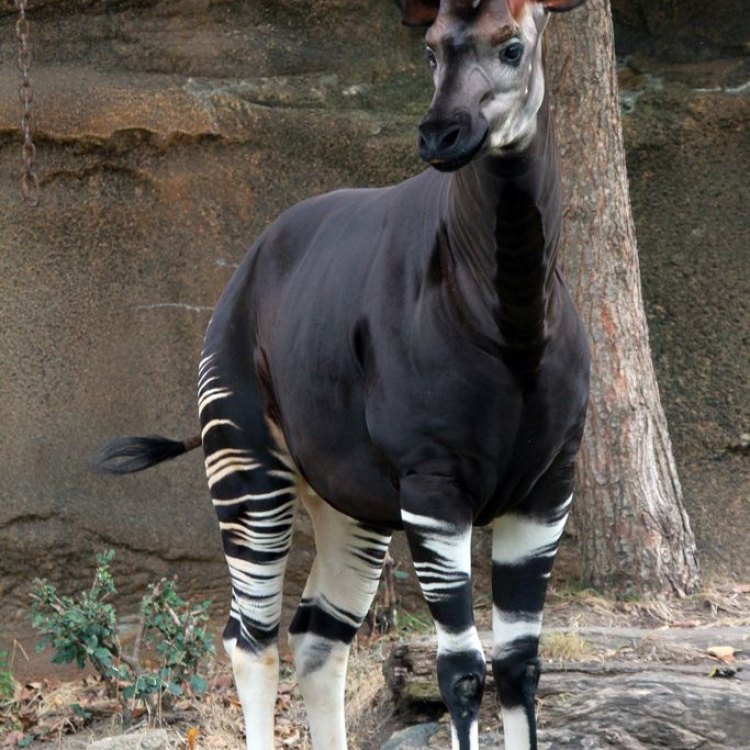
The Elusive Okapi: A Mysterious and Majestic Creature of the Rainforest
Disclaimer: The content provided is for informational purposes only. We cannot guarantee the accuracy of the information on this page 100%. All information provided here may change without prior notice.

